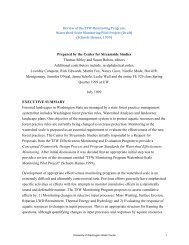c Copyright 2011 Katherine Nichole Deibel Understanding and ...
c Copyright 2011 Katherine Nichole Deibel Understanding and ...
c Copyright 2011 Katherine Nichole Deibel Understanding and ...
You also want an ePaper? Increase the reach of your titles
YUMPU automatically turns print PDFs into web optimized ePapers that Google loves.
2 Chapter 1<br />
merit, necessitating the development of new literacy skills to address the limitations of writing (e.g., source<br />
evaluation (Britt & Aglinskas, 2002)). Today, writing <strong>and</strong> reading pervade our society; we even refer to the<br />
current era as the Information Age. Theuth’s invention has dramatically impacted our lives in ways predicted<br />
<strong>and</strong> not predicted by King Thamus/Socrates.<br />
At the same time, many innovations <strong>and</strong> inventions fail to make an impact. Trivia books <strong>and</strong> Ripley’s<br />
Believe It or Not! comics are littered with examples of fanciful inventions that trigger laughter (Ripley, 1990).<br />
From squirting alarm clocks <strong>and</strong> Edison’s concrete furniture (Ripley, 1990) to revolving medical beds for<br />
facilitating labor via centrifugal force (Abrahams, 2002), the designers of such technologies hoped, like<br />
Theuth, to improve <strong>and</strong> benefit the lives of others. No one adopted these technologies into regular use, though<br />
<strong>and</strong> their impacts have sadly been limited to filing cabinets in various patent offices.<br />
The many elements of this journey from Socrates to Ripley are of concern here in this dissertation. Without<br />
question, reading <strong>and</strong> literacy are critical skills necessary for participation in today’s information society. For<br />
the 7–15% of the population with reading disabilities (RDs) (S<strong>and</strong>s & Buchholz, 1997), however, participation<br />
can thus be a challenge <strong>and</strong> source of stress. As information is increasingly available in digital form, computing<br />
technologies seem an increasingly viable means of support <strong>and</strong> accommodation. However, there is a catch—<br />
said technologies must be adopted into regular use. Unfortunately, studies have shown that, on average, at<br />
least one third of all assistive 1 technologies are ab<strong>and</strong>oned 2 after purchase (Martin & McCormack, 1999;<br />
Riemer-Reiss & Wacker, 2000). When designing technologies expressly for the purpose of benefiting the lives<br />
of reading-disabled users, underst<strong>and</strong>ing the many factors (sociocultural, technical, economic, environmental,<br />
etc.) that influence the adoption, usage, <strong>and</strong> ab<strong>and</strong>onment of these technologies is crucial. This dissertation<br />
is a study of these factors <strong>and</strong> how they influence the adoption <strong>and</strong> usage of technologies by adults with<br />
reading disabilities. Although the primary focus is on assistive technologies, technologies of all kinds are also<br />
considered <strong>and</strong> studied. In the coming chapters, I investigate the factors that shape technology usage, illustrate,<br />
their many nuances, <strong>and</strong> implement solutions that utilize my findings to better promote adoption <strong>and</strong> ongoing<br />
usage of technologies for users with reading disabilities.<br />
1 Assistive Technologies <strong>and</strong> the Need for Adoption<br />
At face value, successful adoption is important for any technology, be it assistive or not. Consumers do not<br />
wish to waste their money. Most designers want their ideas to come to fruition <strong>and</strong> be used. Manufacturers<br />
most certainly want consumers to purchase their wares. Moreover, although a product that gets purchased <strong>and</strong><br />
is then shortly ab<strong>and</strong>oned does provide some monetary profit, a manufacturer is better favored by long-term<br />
usage of a product <strong>and</strong> the associated return customers <strong>and</strong> marketing benefits of other consumers seeing the<br />
product in use (Rogers, 2003). Plainly put, technology adoption is an important issue to many parties.
















